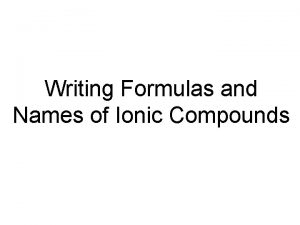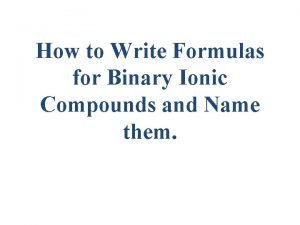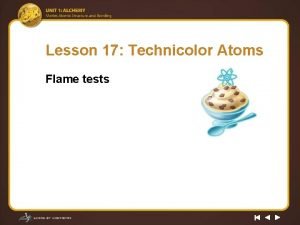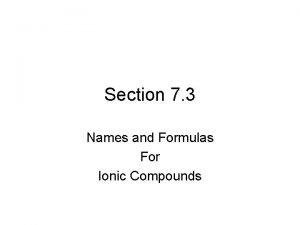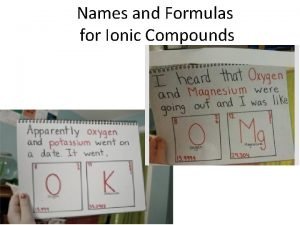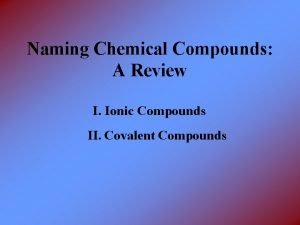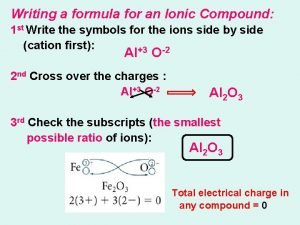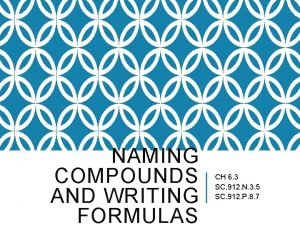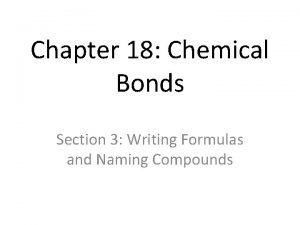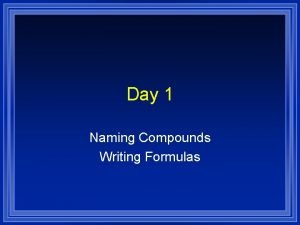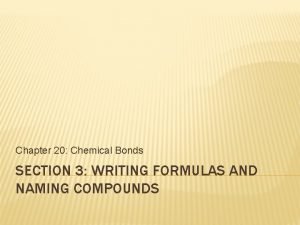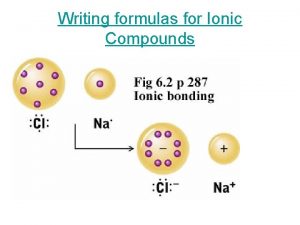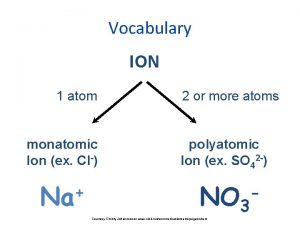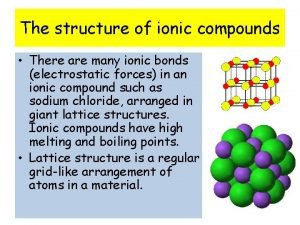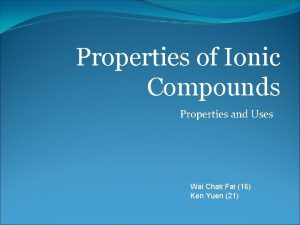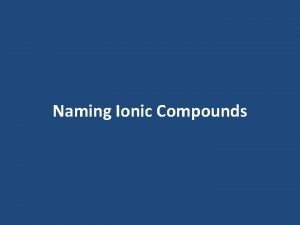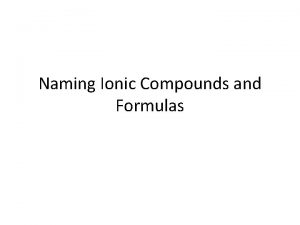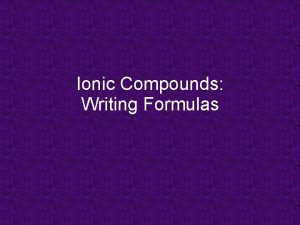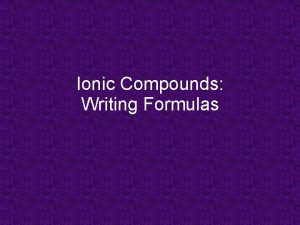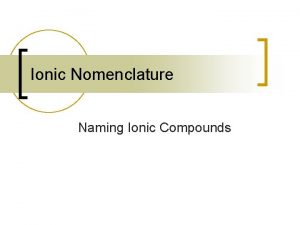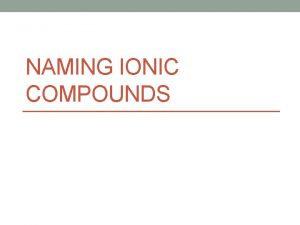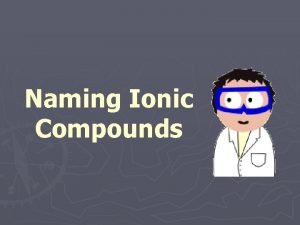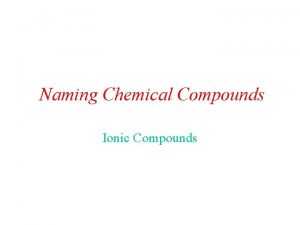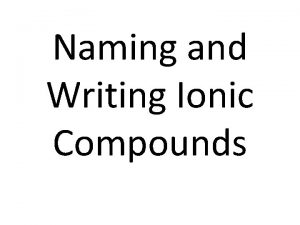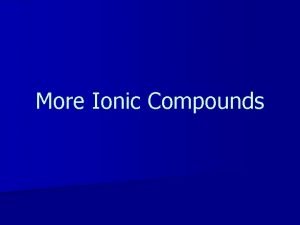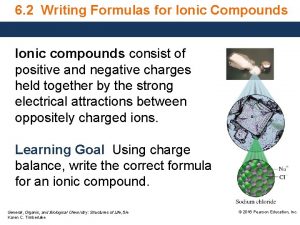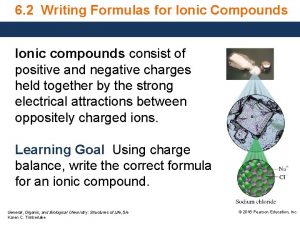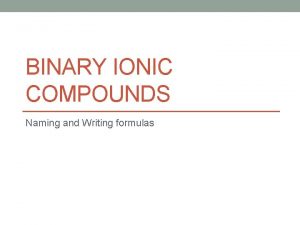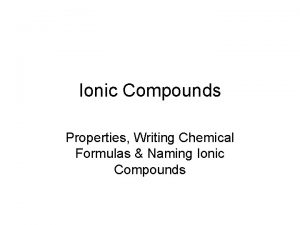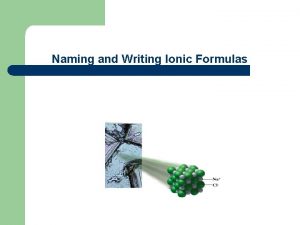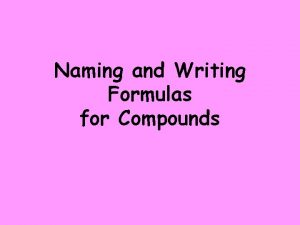Ionic Compounds Writing Formulas Empirical Formulas formulas with






















- Slides: 22

Ionic Compounds: Writing Formulas

Empirical Formulas formulas with smallest whole-number ratio of elements in compound ionic compounds only written as empirical formulas

Identify Formulas: ? empirical vs molecular ? ionic • • H 2 O empirical – NOT ionic H 2 O 2 molecular – NOT ionic Ca. F 2 empirical, ionic Na. Cl empirical, ionic CH 4 empirical – NOT ionic C 2 H 6 molecular – NOT ionic Ni. O empirical, ionic Fe. Cl 3 empirical, ionic

Formula Unit simplest ratio of ions in ionic compound examples: • KBr is formula unit – potassium ions & bromide ions are in a 1 -to-1 ratio • Al. Cl 3 is formula unit – aluminum & chloride ions in 1 -to-3 ratio

Binary Ionic Compounds • composed of two different elements – since ionic: • positive monatomic metal ion • negative monatomic non-metal ion note: binary compound may contain more than 2 ions but only 2 kinds of ions (ex: Al 2 O 3)

Oxidation Number or State • charge of monatomic ion (right superscript) Na+1 Ca+2 O-2 • some elements form only 1 ion Al+3 Ag+1 • some elements can form more than 1 ion Fe+2 Fe+3

Oxidation States A group elements: • group 1 ions always +1 • group 2 ions always +2 • MOST group 13 ions are +3 • groups 14, 15, 16, and 17 have multiple oxidation states – both (+) and (-) B group elements (transition metals): • can have more than 1 oxidation state – but are always (+)

Writing Formulas for Binary Ionic Compounds first rule in writing formulas POSITIVE ION FIRST how get the subscripts? start by writing formulas from the ions

• reminder: compounds are electrically neutral therefore sum of all charges in compound MUST be 0 (+) and (-) charges must = each other

Equal but Opposite Charges • Na+1 and Cl-1: Na. Cl +1 + (-1) = 0 • Mg+2 and O-2: Mg. O +2 + (-2) = 0 • Al+3 and P-3: +3 + (-3) = 0 Al. P • rule: write symbols, (+) FIRST! FIRST

try a few formulas: • • • Li+1 and I-1 Ca+2 and O-2 Al+3 and N-3 K+1 and F-1 Ba+2 and S-2 Li. I Ca. O Al. N KF Ba. S

Criss-Cross Method charges opposite but NOT equal: • Mg+2 and Cl-1, CROSS and DROP! (# only, forget signs!) • Mg 1 Cl 2 (if subscript is 1, forget it!) Mg. Cl 2

Check the Math • Mg. Cl 2 means 1 Mg+2 and 2 Cl-1 (1)(+2) + (2)(-1) = +2 + -2 = 0 • charges MUST add up to zero!

try these: • Ca+2 + Cl-1 • Na+1 + O-2 • Cs+1 + S-2 • Al+3 + Cl-1 Ca. Cl 2 Na 2 O Cs 2 S Al. Cl 3 • Al+3 + Se-2 Al 2 Se 3 • Mg+2 + F-1 • K+1 + N-3 Mg. F 2 K 3 N

of course, it gets more difficult KF • potassium (K) and fluorine (F) • zinc (Zn) and iodine (I) Zn. I 2 Na 2 O • sodium (Na) and oxygen (O) Mg. O • magnesium (Mg) and oxygen (O) • aluminum (Al) and oxygen (O) Al 2 O 3 • calcium (Ca) and bromine (Br) Ca. Br 2 • cesium (Cs) and iodine (I) • silver (Ag) and sulfur (S) Cs. I Ag 2 S

and more challenging • gold +1 and fluorine Au. F • gold +3 and fluorine Au. F 3 • titanium +2 and oxygen • titanium +3 and oxygen • titanium +4 and oxygen Ti. O Ti 2 O 3 Ti 2 O 4 • manganese +4 and bromine • manganese +7 and bromine Ti O 2 Mn. Br 4 Mn. Br 7

POLYATOMIC IONS • Table E: groups of covalently bonded atoms that have a charge (+) or (–) • polyatomic ions have “names” • (-) polyatomic ions can form ionic bonds with (+) metal ions SO 42 - CO 32 - PO 43 - OH 1 -

Ternary Compounds • contain 3 or more elements • usually contain a polyatomic ion: – if polyatomic is (+) it’s bonded to something () charged – either(-) non-metal ion or (-) poly ion – if polyatomic is (–) it’s bonded to (+)metal ion

Formulas with Polyatomics • What’s the formula for the compound formed from Al+3 and SCN-1? • charges must add up to zero • write symbols, positive first! • figure out how many of each ion needed Al(SCN)3

easy ones with equal but opposite charges: • • • Na+1 and OH-1 K +1 and HCO 3 -1 Mg+2 and CO 3 -2 Li +1 and NO 3 -1 Ca+2 and SO 4 -2 Na. OH KHCO 3 Mg. CO 3 Li. NO 3 Ca. SO 4

these are more challenging: • • • Mg+2 and (PO 4)-3 Al+3 and (NO 3)-1 Fe+2 and OH-1 Hg 2+2 and SCN-1 Mg+2 and HCO 3 -1 Al+3 and C 2 O 4 -2 Mg 3(PO 4)2 Al(NO 3)3 Fe(OH)2 Hg 2(SCN)2 Mg(HCO 3)2 Al 2(C 2 O 4)3

more challenging • • • Zn(NO 3)2 zinc + nitrate ion magnesium + hydroxide ion Mg(OH)2 lithium + carbonate ion Li 2 CO 3 K 2 SO 4 potassium + sulfate ion calcium + phosphate ion Ca 3(PO 4)2 beryllium + chlorate ion Be (Cl. O 3)2
 Monatomic ion definition chemistry
Monatomic ion definition chemistry Writing formulas from names
Writing formulas from names Ionic and covalent bond venn diagram
Ionic and covalent bond venn diagram Ag3po4
Ag3po4 Ionic naming rules
Ionic naming rules Lesson 17 technicolor atoms flame test
Lesson 17 technicolor atoms flame test Section 3 names and formulas for ionic compounds
Section 3 names and formulas for ionic compounds Section 3 names and formulas for ionic compounds
Section 3 names and formulas for ionic compounds Naming compounds review
Naming compounds review Chemical formulas
Chemical formulas Naming compounds and writing formulas
Naming compounds and writing formulas Section 3 writing formulas and naming compounds
Section 3 writing formulas and naming compounds Tetraiodine nonaoxide formula
Tetraiodine nonaoxide formula Section 3 writing formulas and naming compounds
Section 3 writing formulas and naming compounds Writing formulas (criss cross method)
Writing formulas (criss cross method) Ternary ionic compounds
Ternary ionic compounds Monatomic ions
Monatomic ions Why are ionic compunds brittle
Why are ionic compunds brittle Solubility and molarity relationship
Solubility and molarity relationship Ionic compounds
Ionic compounds Cl-1 ion name
Cl-1 ion name Chemical
Chemical Ternary ionic compounds
Ternary ionic compounds

